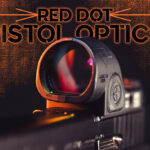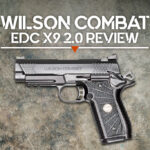
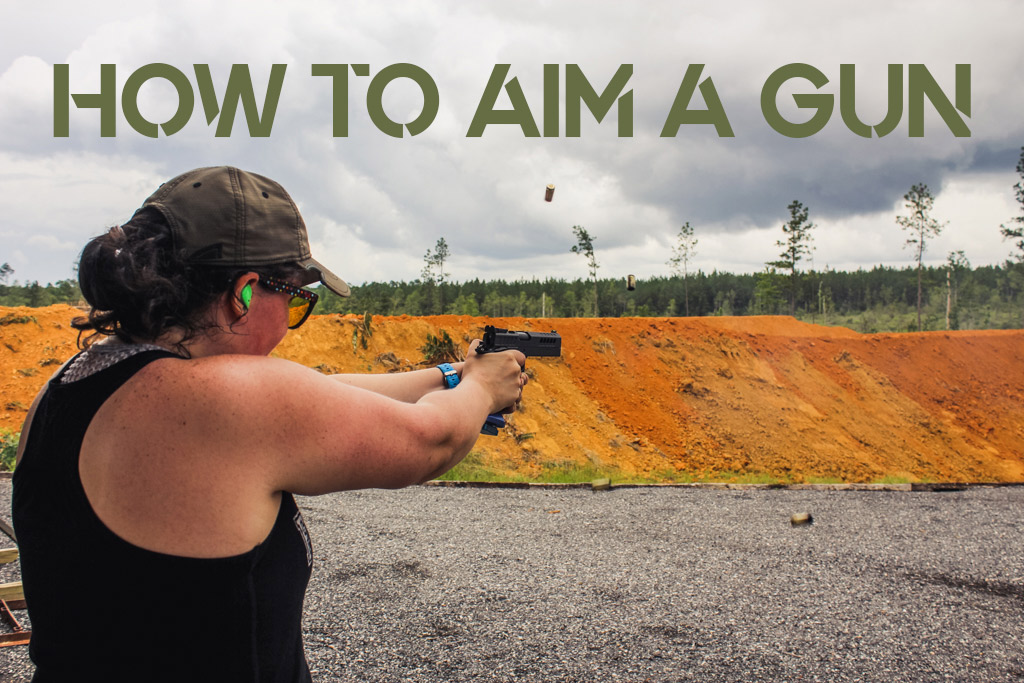
Guest Writer: Kenzie Fitzpatrick
From the newest shooters to advanced shooters, learning how to aim a gun properly can take time. In this article, we’ll be going over how to aim using the most common sight types. Aiming with iron sights on a pistol, aiming a shotgun with a front bead sight and no rear sight, and how to aim a rifle using stock iron sights.
Types Of Gun Sights
If you’re not familiar with gun sight terminology, I’ll explain it for you below.
- Front Sight/Rear Sight – Almost all modern guns have a pair of sights attached to them for aiming purposes. The front sight is located at the end of the gun barrel, the rear sight is located closest to the shooter holding the weapon.
- Iron Sights – Also sometimes called simple, or open sights, these sights are affixed sights that come standard on almost all firearms. The front iron sight is generally a singular blade shape, while rear iron sight comes in a variety of different shapes. Iron sights can be found on a variety of gun types including rifles and pistols.
- Bead Sights – Most commonly found on shotguns, bead sights are a round shape, usually made of metal, that sits on the end of the gun barrel. Bead sights are commonly used on guns that do not have a pronounced rear sight. It’s also common for some revolver models to have a front bead sight, along with a low-profile rear sight.
Understanding Aiming
Learning the base knowledge of how to aim using a rear sight and a front sight will give you the know-how and skills necessary to head to the range confidently. Even if you outfit your guns with a red dot or a scope, it’s always a good idea to keep your iron sights on the gun. When optics fail, you can always rely on iron sights to shoot accurately.
Learning how to aim a gun can vary from one gun to the next. While aiming is a part of accurately shooting a gun, it’s just one shooting fundamental that works together with breath control, hold control, trigger control, and follow-through. You need all of these to make the perfect shot.
How To Aim A Gun: Getting Started
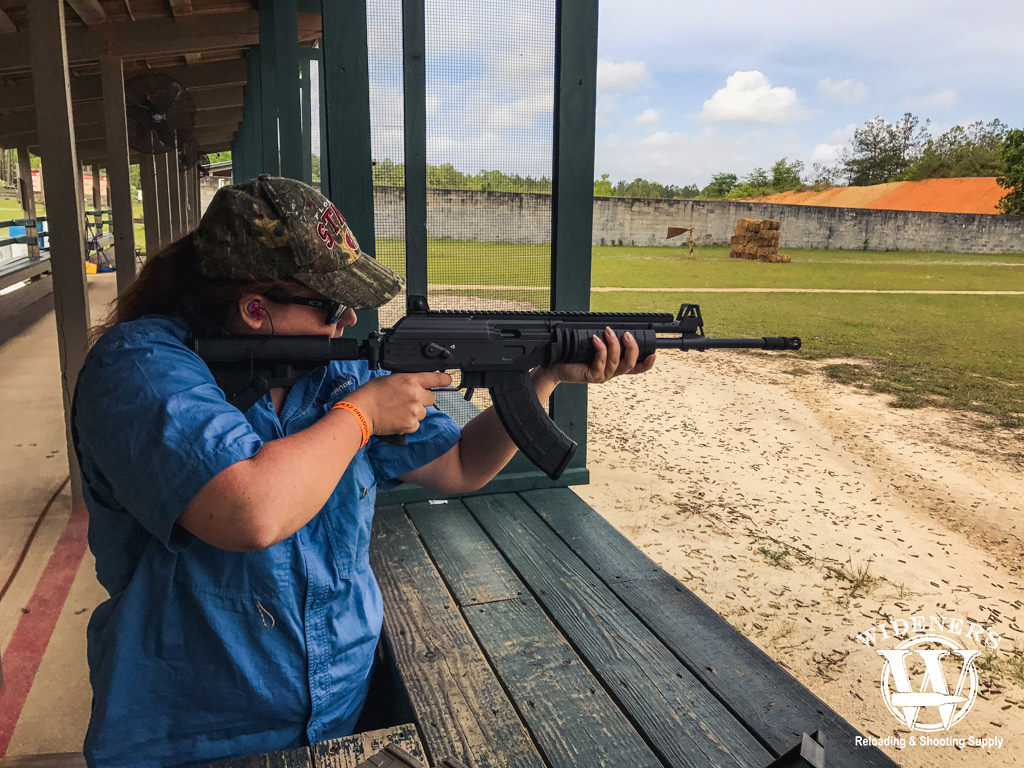
Most modern guns come with front and rear iron sights installed to help owners accurately aim at targets.
Before learning how to aim a gun, there are a few common questions that frequently come up. I’ll go over them below.
- Can I adjust my sights? Yes, most iron sights are adjustable. Rear sights can be adjusted for windage and elevation. The way people aim and see targets is not the same. So, believe it or not, your iron sights may have to be adjusted for you to achieve accuracy. It’s normally recommended to have a professional gunsmith make adjustments to your sights.
- Why does my front sight have a color? Most manufacturers will mark the front iron sight of a weapon with a white or red dot of high-visibility paint. The idea is to allow you to be able to see the front sight clearly while aiming at a target in front of a variety of different lighting situations and backgrounds.
- What if my front sight is fiber optic? If your front iron sight is fiber optic, make sure you can see the color well. Fiber optics come in a variety of colors. For example, green is the most visible color for me, however, red may be easier for you to see. When you’re aiming with iron sights, the front sight is the focal point, so visibility is crucial to achieving an accurate aim.
- What about mounted optics? Just like iron sights, mounted optics like red dots and scopes have to be sighted in for your field of vision. Read the manual of your chosen optic to properly sight it in so you know your aim is true.
Aiming Basics: Sight Alignment
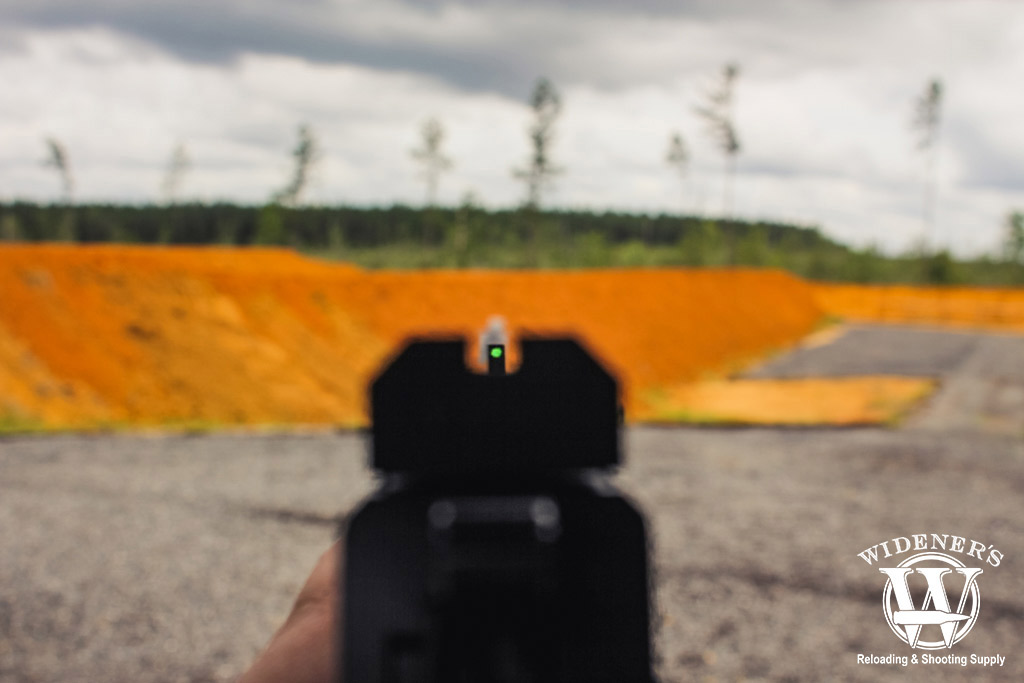
Make sure your front sight is in focus and aligned with your rear sight and the target when aiming.
Before diving into the different types of guns, let’s go over the basics of how to aim a gun. A proper aim involves the target, the rear sight, and most importantly, the front sight. Sight alignment and sight picture are the two components that make up an accurate aim point.
Sight alignment is the process of lining up the rear and front sights properly. For the easiest example, all three circles should be even, straight across, when aiming for the perfect shot. Sight picture is putting the aligned sights onto the target in the desired location to hit the target dead center.
Keeping your sight alignment while finding your target is where things get tricky. Your front sight should be over the spot you want to hit. Your the rear sights should line up with the front sight from there. Once you have sight alignment and a proper sight picture, your eyes should focus on your front sight only before taking the shot. With so many options of irons sights and optics on the market, these will give you a general overview of how to aim a gun.
Aiming A Pistol
From revolvers to semi-automatics, pistol iron sights are the easiest sights to learn how to aim with. A proper sight alignment for iron sights is the rear sight aligned with the front sight. Some rear sights will be shaped like a “U” while others can be shaped with a “V.”
I prefer circle dotted, night sights that show white during the day, and glow green in the dark. Having all three circles in a line will give an accurate point of aim. Another example that has the same principle when aiming, but looks way different are Speed Sights. Even though the sights are diamonds, all three should be in alignment for an accurate shot.
Aiming A Revolver
Some revolvers do not have a rear sight. The metal above the cylinder of a revolver will have a groove machined out of it that helps form a sight picture. The front sight of a revolver will typically be a metal blade or notch post. Revolver sights like these are fixed meaning there’s only one way to aim it. The front blade or post should be lined up to be flush and even in the groove of the rear of the gun. If you were to set a table on top of the revolver, the sights would be in alignment.
If your revolver does have a rear sight, align it just as you would a semi-automatic.
When the front and rear sights are the same widths, it’s extremely hard to see your target with your sights aligned. As mentioned in “How to Shoot with Both Eyes Open”, I switched my front sight to a skinnier sight so I can see my target between my front sight when it’s aligned with the rear sights.
Aiming A Shotgun
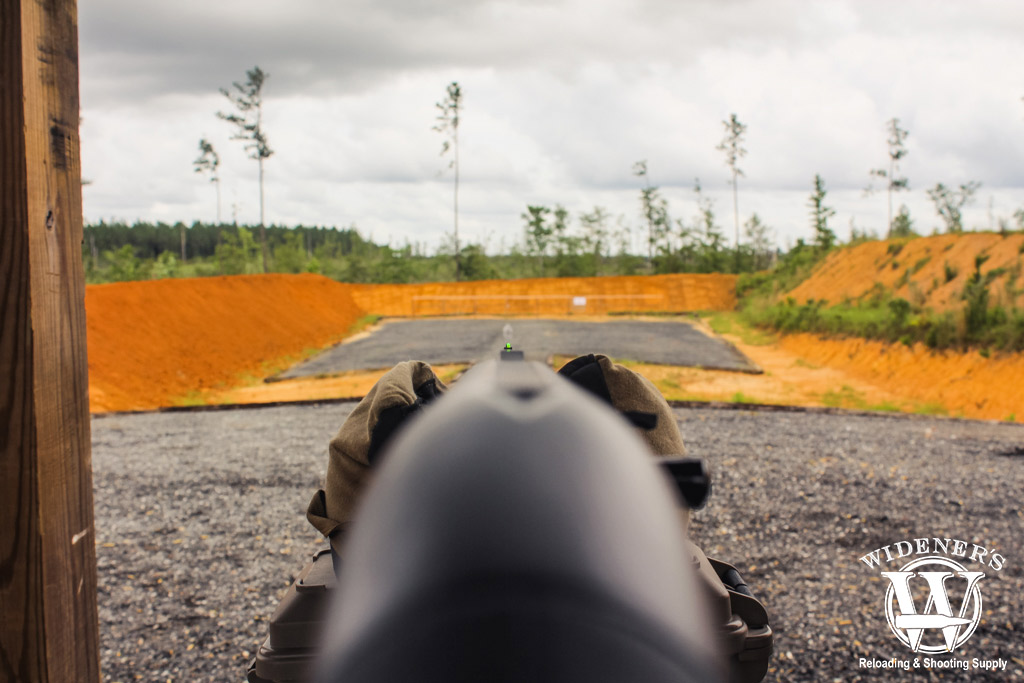
The simplicity of a shotgun’s bead sight is designed for quick visual acquisition of moving targets.
Aiming a shotgun is vastly different than aiming a rifle or a pistol. Most shotguns don’t come with a rear sight. Shotguns are designed for your eye to be the rear sight of the gun. Some shotguns do, however, have the ability for a gunsmith to add a rear sight to it which makes it easier to aim especially when shooting far slug shots.
The front sight of a shotgun is typically a bead or fiber optic and occasionally a notch or blade. Just like a pistol, your front sight should be your point of focus when shooting. A cheek weld is where your cheek comes to rest on the stock of the shotgun. This is what forms your “rear sight” or eye sightline. When you have a shotgun target, your front sight should be in the center of the target where it’s in line with your eyesight.
Most shotgun targets are moving targets. Aiming a shotgun requires the shooter to always be focused on the front sight while keeping it dead center of the target. If you break your eyesight to the left or right losing track of the target, you will miss the shot. At all times, your dominant eye has to be on the front sight keeping the sights aligned.
The key to aiming a shotgun is repetition. The cheek weld you form is the base of your sight alignment. The minute your cheek weld comes off the gun, the sights are no longer aligned.
Aiming A Rifle
These days, stock rifles come with all sorts of different iron sights. For example, my lever-action rifle has a bead for a front sight while my semi-automatic rifle came with a post as the front sight and circular hole rear sight. When you have a set of iron sights on a rifle, the concept of aiming should be pretty intuitive after learning how to aim a pistol and shotgun.
If the rear and front sights are set up like pistol iron sights, align them across so they’re even. Do you have a circular rear sight and notch front sight? If so, the tip of the front sight should be centered in the circular rear sight for an accurate shot. If you have a bead at the front and a groove towards the rear similar to a revolver, aim it the same way.
Why Iron Sights?
I was taught to always learn how to shoot using iron sights on any gun for a variety of reasons.
- Red dot optics can fail when it comes to battery issues and sometimes, even calibration issues. It’s a good idea if you concealed carry with an optic to keep your iron sights mounted if you can and check your battery regularly.
- Scopes can fail the same way and even fall off their mounting system. If you ever lose your red dot or scope, having iron sights as backups never hurt.
- In shooting competitions, iron sight offsets are allowed in all divisions. So, for me, knowing how to use them comes in handy.
- Iron sights also are way more durable, inexpensive, and don’t add much weight to a gun.
- If there’s a rear sight and a front sight, aiming with iron sights is mostly universal across all types of firearms.
Mastering Your Aim
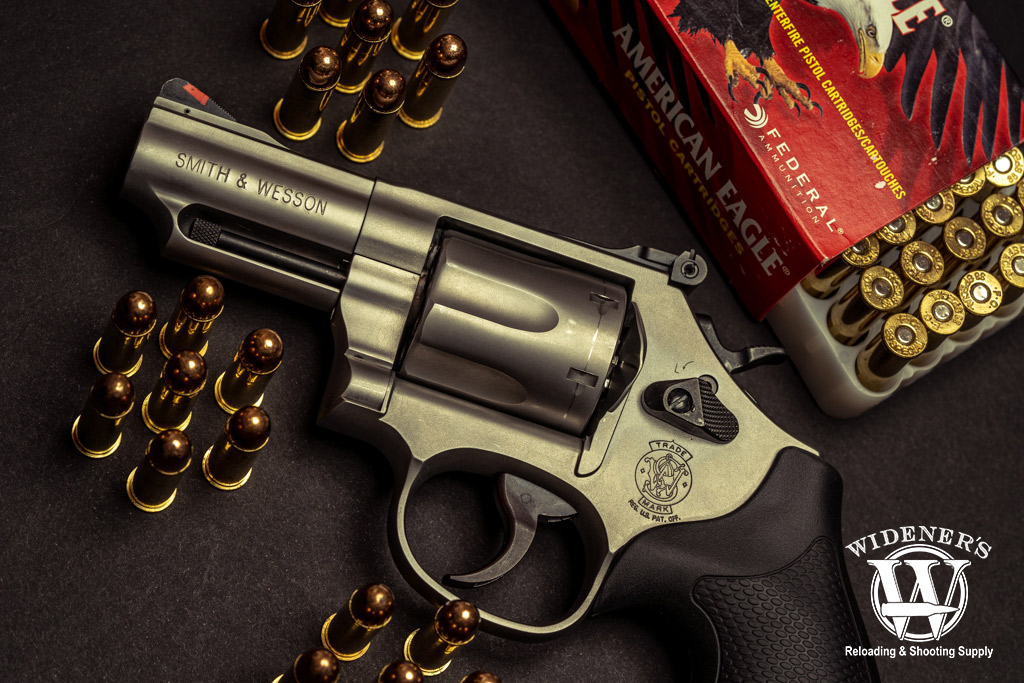
You’ll need to practice your aim with the gun you plan to use so it will be familiar to you in an emergency situation.
Learning to aim a gun isn’t difficult, but it takes a fair amount of practice. How much should you practice? As often as you can, you need to work on your hand-eye coordination and muscle memory. A good suggestion is to practice aiming while dry firing your weapon. Make sure your firearm is unloaded while practicing and be sure to use good trigger discipline.
Once you’ve mastered iron sights, aiming with red dots and optics is easier than ever. Remember that learning how to aim a gun is only one shooting fundamental on making a proper shot. Be sure to practice the other fundamentals and tie them all together for the most accurate shooting experience.


